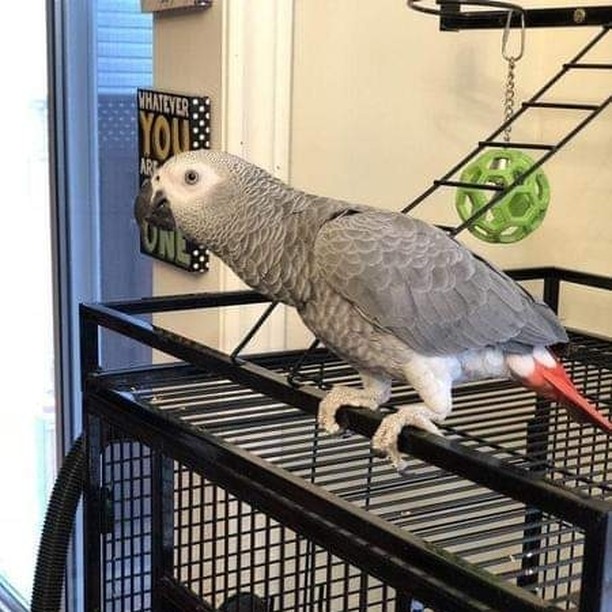African Grey Parrots are widely regarded as one of the most intelligent avian species. Known for their exceptional vocal skills and ability to mimic human speech, these birds make wonderful companions for those willing to invest the time and effort into their care. This article will provide an in-depth overview of caring for African Grey Parrots, covering aspects such as diet, socialization, environment, health, and grooming.
Introduction to African Grey Parrots
African Grey Parrots, primarily recognized for their striking grey plumage and vibrant red tail feathers, are native to the rainforests of Central and West Africa. They are characterized by their remarkable cognitive abilities and vocalization skills, making them highly popular among bird enthusiasts. However, owning an African Grey Parrot comes with its own set of responsibilities. Understanding their needs is crucial for their well-being.
Ideal Environment for African Grey Parrots
Creating a comfortable and safe living environment is vital. Here are some key considerations:
Cage Setup
- Size: The cage should measure at least 24" x 36" x 48" for a single bird, with horizontal bars for climbing.
- Location: Place the cage in a busy area of the home to promote social interaction but ensure it is away from drafts and direct sunlight.
- Perches and Toys: Include multiple perches of varying diameters and several toys to stimulate mental and physical activity.
Table 1: Recommended Cage Accessories
| Accessory | Purpose |
|---|---|
| Perches | Provide primary surfaces for resting and climbing |
| Natural Wood Toys | Encourage chewing and prevent boredom |
| Swings and Ladders | Promote physical activity and coordination |
| Treat Dispensers | Create opportunities for foraging behavior |
Essential Diet for African Grey Parrots
A balanced diet is crucial for the health of African Grey Parrots. Nutritional needs can differ significantly between individuals, but a well-rounded diet typically includes:
Key Dietary Components
- Pelleted Diet: High-quality pellets should make up about 60-70% of their diet.
- Fresh Fruits and Vegetables:
- Fruits: Apples, bananas, and berries.
- Vegetables: Carrots, broccoli, and leafy greens.
- Nuts and Seeds: These should be offered in moderation due to high-fat content.
- Grains and Legumes: Cooked quinoa or lentils can provide additional protein.
- Calcium Supplements: Essential for bone health, especially if the bird is not getting enough from its diet.
Table 2: Sample Weekly Diet Plan
| Day | Pellets | Fruits | Vegetables | Nuts (Optional) |
|---|---|---|---|---|
| Monday | 1/2 cup | 1 small apple | 1/2 cup broccoli | 2 walnuts |
| Tuesday | 1/2 cup | 1/2 banana | 1/2 cup carrots | 5 almonds |
| Wednesday | 1/2 cup | 1/2 cup berries | Mixed leafy greens | 2 hazelnuts |
| Thursday | 1/2 cup | 1/4 pineapple | 1/2 cup bell peppers | 3 pecans |
| Friday | 1/2 cup | 1 small orange | 1/2 cup peas | 2 macadamias |
| Saturday | 1/2 cup | 1/2 cup grapes | 1/2 cup sweet potato | 5 sunflower seeds |
| Sunday | 1/2 cup | 1 kiwi | 1/2 cup zucchini | 3 cashews |
Socialization and Exercise
African Grey Parrots thrive on social interaction. Lack of engagement can lead to behavioral issues such as feather plucking.

Tips for Socialization
- Daily Interaction: Spend at least 2-3 hours daily interacting or playing.
- Training Sessions: Incorporate training sessions to stimulate their minds and reinforce positive behaviors using rewards.
- Routine Playtime: Allow supervised out-of-cage time to explore and exercise in a safe environment.
Health Care
Regular veterinary visits and monitoring health are essential for African Grey Parrots.

Common Health Issues
- Feather Plucking: Often related to stress or boredom.
- Respiratory Problems: Can be caused by poor air quality or exposure to fumes.
- Obesity: Can result from a poor diet and lack of exercise.
Table 3: Recommended Health Care Practices
| Practice | Frequency |
|---|---|
| Avian Vet Check-up | At least once a year |
| Nail Trimming | Every 2-4 weeks |
| Beak Trimming | As needed, consult a vet |
| Feather Health Check | Monthly observation |
Grooming
Routine grooming is also critical for your parrot’s well-being.
Key Grooming Practices
- Bathing: Provide misting or lukewarm baths a few times a week to keep feathers clean.
- Nail Care: Trim nails regularly to prevent overgrowth.
- Beak Care: Monitor beak length and shape; provide chew toys to help with wear.
FAQs About African Grey Parrot Care
How long do african grey Parrot care Grey Parrots live?
- With proper care, African Grey Parrots can live anywhere from 40 to 60 years.
Can African Grey Parrots talk?
- Yes, they are known for their ability to mimic speech and various sounds.
What should I do if my parrot starts plucking its feathers?
- Consult an avian veterinarian to assess the cause, as it could be related to stress, boredom, or medical issues.
Are African Grey Parrots good pets for beginners?
- While they are intelligent and can form strong bonds, they require significant time and attention, making them more suitable for experienced bird owners.
What toys are best for African Grey Parrots?
- Durable toys that encourage foraging and chewing, such as wood blocks, shreddable materials, and puzzle toys.
Caring for an African Grey Parrot is a rewarding yet demanding endeavor. With proper attention to diet, environment, socialization, health, and grooming, these wonderfully intelligent birds can thrive and become cherished members of your family. By committing to their well-being, owners can enjoy many years of companionship and joy from their African Grey Parrot.






